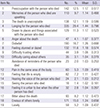1. Horowitz MJ, Siegel B, Holen A, Bonanno GA, Milbrath C, Stinson CH. Diagnostic criteria for complicated grief disorder. Am J Psychiatry. 1997; 154:904–910.
2. Prigerson HG, Maciejewski PK, Reynolds CF 3rd, Bierhals AJ, Newsom JT, Fasiczka A, Frank E, Doman J, Miller M. Inventory of Complicated Grief: a scale to measure maladaptive symptoms of loss. Psychiatry Res. 1995; 59:65–79.
3. Prigerson HG, Horowitz MJ, Jacobs SC, Parkes CM, Aslan M, Goodkin K, Raphael B, Marwit SJ, Wortman C, Neimeyer RA, et al. Prolonged grief disorder: Psychometric validation of criteria proposed for DSM-V and ICD-11. PLoS Med. 2009; 6:e1000121.
4. Shear MK, Simon N, Wall M, Zisook S, Neimeyer R, Duan N, Reynolds C, Lebowitz B, Sung S, Ghesquiere A, et al. Complicated grief and related bereavement issues for DSM-5. Depress Anxiety. 2011; 28:103–117.
5. Schwartzberg SS, Janoff-Bulman R. Grief and the search for meaning: exploring the assumptive worlds of bereaved college students. J Soc Clin Psychol. 1991; 10:270–288.
6. Melhem NM, Porta G, Shamseddeen W, Walker Payne M, Brent DA. Grief in children and adolescents bereaved by sudden parental death. Arch Gen Psychiatry. 2011; 68:911–919.
7. Brent D, Melhem N, Donohoe MB, Walker M. The incidence and course of depression in bereaved youth 21 months after the loss of a parent to suicide, accident, or sudden natural death. Am J Psychiatry. 2009; 166:786–794.
8. Melhem NM, Walker M, Moritz G, Brent DA. Antecedents and sequelae of sudden parental death in offspring and surviving caregivers. Arch Pediatr Adolesc Med. 2008; 162:403–410.
9. Gupta S, Bonanno GA. Complicated grief and deficits in emotional expressive flexibility. J Abnorm Psychol. 2011; 120:635–643.
10. Luebbe AM, Fussner LM, Kiel EJ, Early MC, Bell DJ. Role of adolescent and maternal depressive symptoms on transactional emotion recognition: context and state affect matter. Emotion. 2013; 13:1160–1172.
11. Boelen PA, van den Bout J, de Keijser J. Traumatic grief as a disorder distinct from bereavement-related depression and anxiety: a replication study with bereaved mental health care patients. Am J Psychiatry. 2003; 160:1339–1341.
12. O'Connor M, Lasgaard M, Shevlin M, Guldin MB. A confirmatory factor analysis of combined models of the Harvard Trauma Questionnaire and the Inventory of Complicated Grief-Revised: are we measuring complicated grief or posttraumatic stress? J Anxiety Disord. 2010; 24:672–679.
13. Tsutsui T, Hasegawa Y, Hiraga M, Ishiki M, Asukai N. Distinctiveness of prolonged grief disorder symptoms among survivors of the Great East Japan Earthquake and Tsunami. Psychiatry Res. 2014; 217:67–71.
14. Bunting BP, Adamson G, Mulhall P. A Monte Carlo examination of MTMM model with planned incomplete data structures. Struct Equ Modeling. 2002; 9:369–389.
15. Shear K, Frank E, Houck PR, Reynolds CF 3rd. Treatment of complicated grief: a randomized controlled trial. JAMA. 2005; 293:2601–2608.
16. Kovacs M. Children's depression inventory. North Tonawanda, NY: Multi-Health Systems, Inc;1992.
17. Stanley B, Brown G, Brent DA, Wells K, Poling K, Curry J, Kennard BD, Wagner A, Cwik MF, Klomek AB, et al. Cognitive-behavioral therapy for suicide prevention (CBT-SP): treatment model, feasibility, and acceptability. J Am Acad Child Adolesc Psychiatry. 2009; 48:1005–1013.
18. Greenwald R, Rubin A. Assessment of posttraumatic symptoms in children: development and preliminary validation of parent and child scales. Res Soc Work Pract. 1999; 9:61–75.
19. Hu LT, Bentler PM. Cutoff criteria for fit indexes in covariance structure analysis: conventional criteria versus new alternatives. Struct Equ Modeling. 1999; 6:1–55.
20. Anastasi A, Urbina S. Psychological testing. 7th ed. Upper Saddle River, NJ: Prentic Hall;1997.
21. Librach SL, O'Brien H. Supporting children's grief within an adult and pediatric palliative care program. J Support Oncol. 2011; 9:136–140.
22. Shin JU, Jeong SH, Chung US. The Korean Version of the Adolescent Dissociative Experience Scale: Psychometric properties and the connection to trauma among Korean adolescents. Psychiatry Investig. 2009; 6:163–172.
23. Jeon HJ, Bae J, Woo JM. Recent statistics and risk factors of suicide in children and adolescents. J Korean Med Assoc. 2013; 56:93–99.
24. Melhem NM, Day N, Shear MK, Day R, Reynolds CF 3rd, Brent D. Traumatic grief among adolescents exposed to a peer's suicide. Am J Psychiatry. 2004; 161:1411–1416.








 PDF
PDF ePub
ePub Citation
Citation Print
Print



 XML Download
XML Download